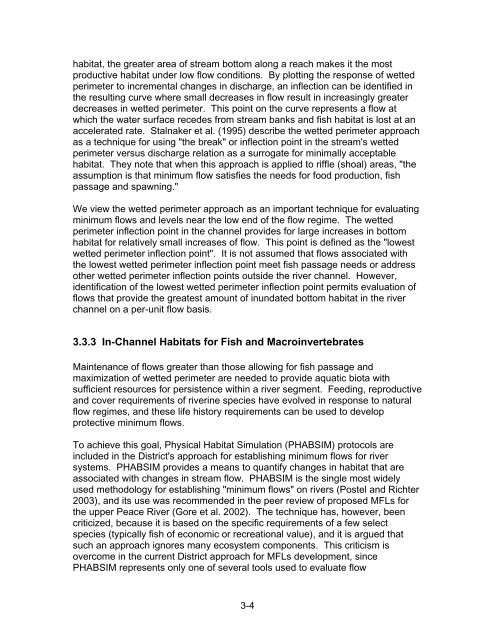Chapter 1 Minimum Flows and Levels - Southwest Florida Water ...
Chapter 1 Minimum Flows and Levels - Southwest Florida Water ...
Chapter 1 Minimum Flows and Levels - Southwest Florida Water ...
Create successful ePaper yourself
Turn your PDF publications into a flip-book with our unique Google optimized e-Paper software.
habitat, the greater area of stream bottom along a reach makes it the most<br />
productive habitat under low flow conditions. By plotting the response of wetted<br />
perimeter to incremental changes in discharge, an inflection can be identified in<br />
the resulting curve where small decreases in flow result in increasingly greater<br />
decreases in wetted perimeter. This point on the curve represents a flow at<br />
which the water surface recedes from stream banks <strong>and</strong> fish habitat is lost at an<br />
accelerated rate. Stalnaker et al. (1995) describe the wetted perimeter approach<br />
as a technique for using "the break" or inflection point in the stream's wetted<br />
perimeter versus discharge relation as a surrogate for minimally acceptable<br />
habitat. They note that when this approach is applied to riffle (shoal) areas, "the<br />
assumption is that minimum flow satisfies the needs for food production, fish<br />
passage <strong>and</strong> spawning."<br />
We view the wetted perimeter approach as an important technique for evaluating<br />
minimum flows <strong>and</strong> levels near the low end of the flow regime. The wetted<br />
perimeter inflection point in the channel provides for large increases in bottom<br />
habitat for relatively small increases of flow. This point is defined as the "lowest<br />
wetted perimeter inflection point". It is not assumed that flows associated with<br />
the lowest wetted perimeter inflection point meet fish passage needs or address<br />
other wetted perimeter inflection points outside the river channel. However,<br />
identification of the lowest wetted perimeter inflection point permits evaluation of<br />
flows that provide the greatest amount of inundated bottom habitat in the river<br />
channel on a per-unit flow basis.<br />
3.3.3 In-Channel Habitats for Fish <strong>and</strong> Macroinvertebrates<br />
Maintenance of flows greater than those allowing for fish passage <strong>and</strong><br />
maximization of wetted perimeter are needed to provide aquatic biota with<br />
sufficient resources for persistence within a river segment. Feeding, reproductive<br />
<strong>and</strong> cover requirements of riverine species have evolved in response to natural<br />
flow regimes, <strong>and</strong> these life history requirements can be used to develop<br />
protective minimum flows.<br />
To achieve this goal, Physical Habitat Simulation (PHABSIM) protocols are<br />
included in the District's approach for establishing minimum flows for river<br />
systems. PHABSIM provides a means to quantify changes in habitat that are<br />
associated with changes in stream flow. PHABSIM is the single most widely<br />
used methodology for establishing "minimum flows" on rivers (Postel <strong>and</strong> Richter<br />
2003), <strong>and</strong> its use was recommended in the peer review of proposed MFLs for<br />
the upper Peace River (Gore et al. 2002). The technique has, however, been<br />
criticized, because it is based on the specific requirements of a few select<br />
species (typically fish of economic or recreational value), <strong>and</strong> it is argued that<br />
such an approach ignores many ecosystem components. This criticism is<br />
overcome in the current District approach for MFLs development, since<br />
PHABSIM represents only one of several tools used to evaluate flow<br />
3-4
















